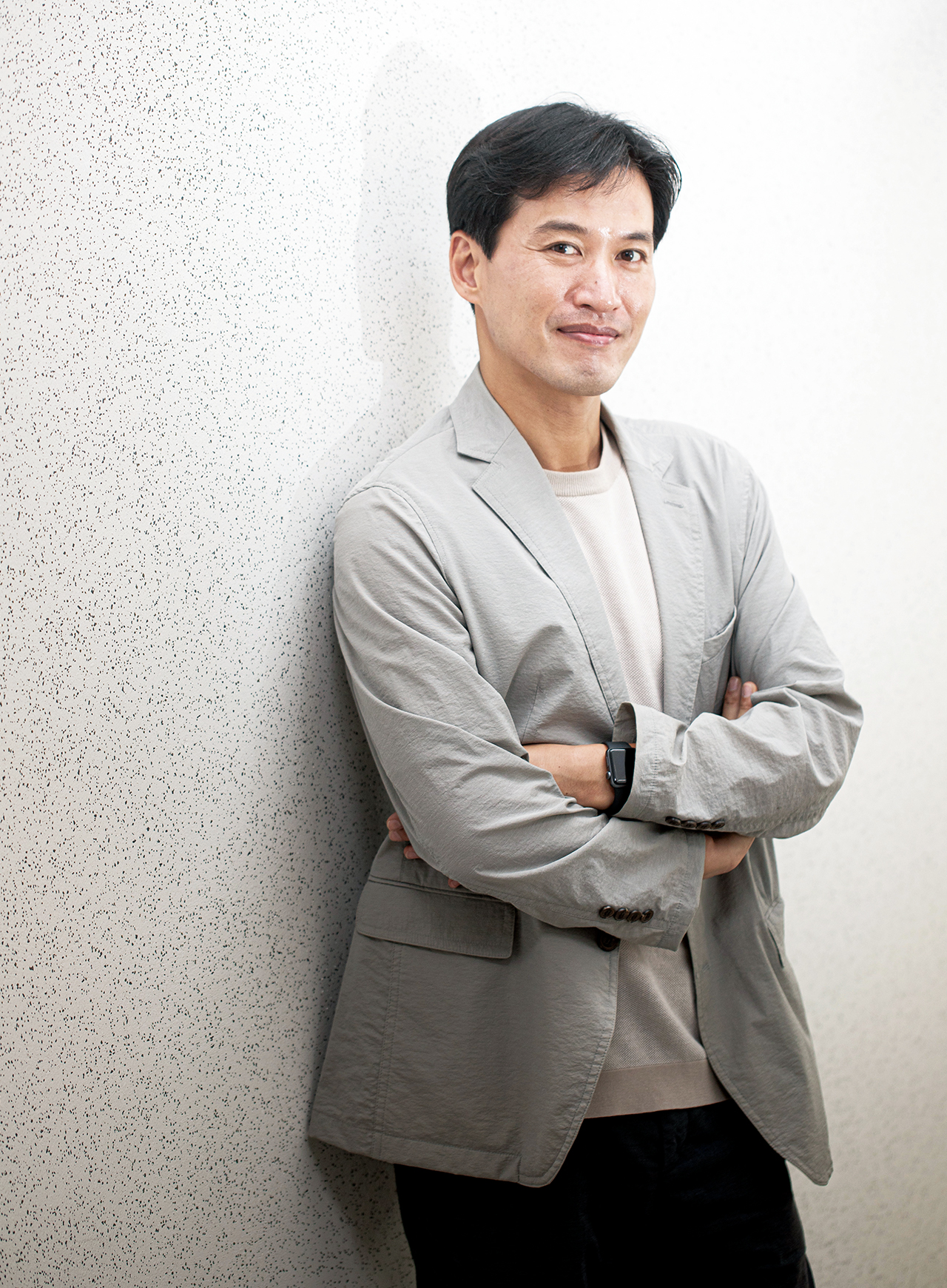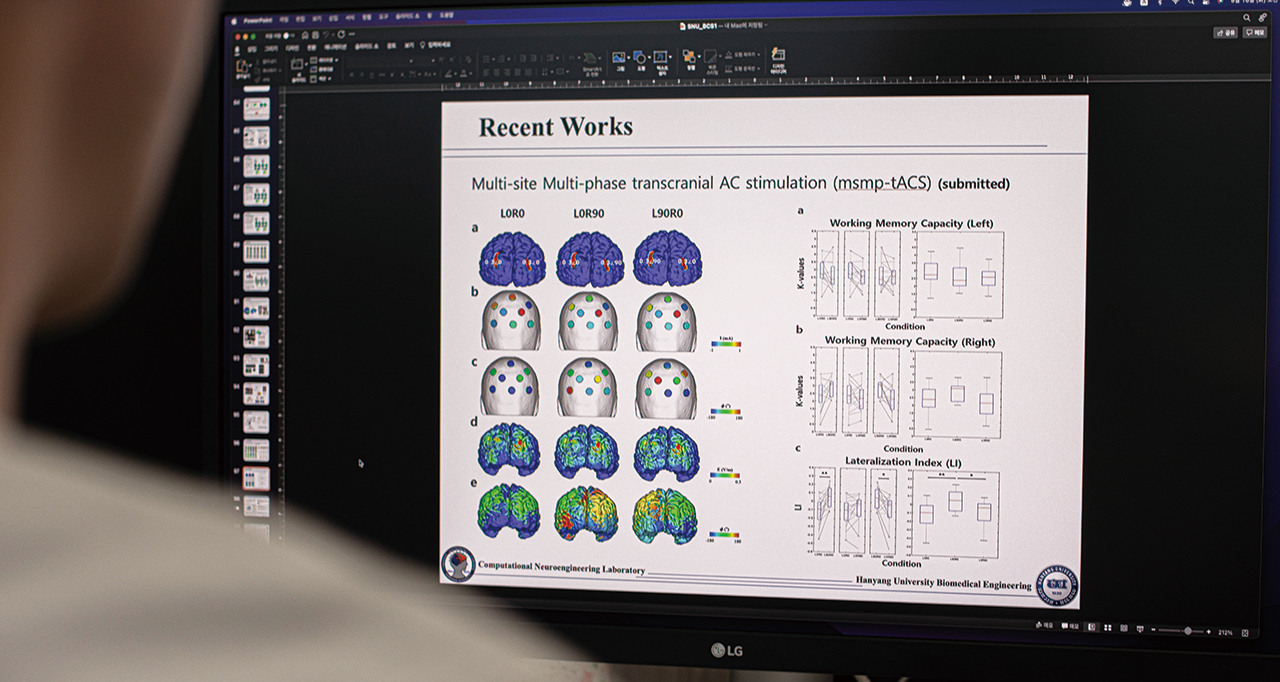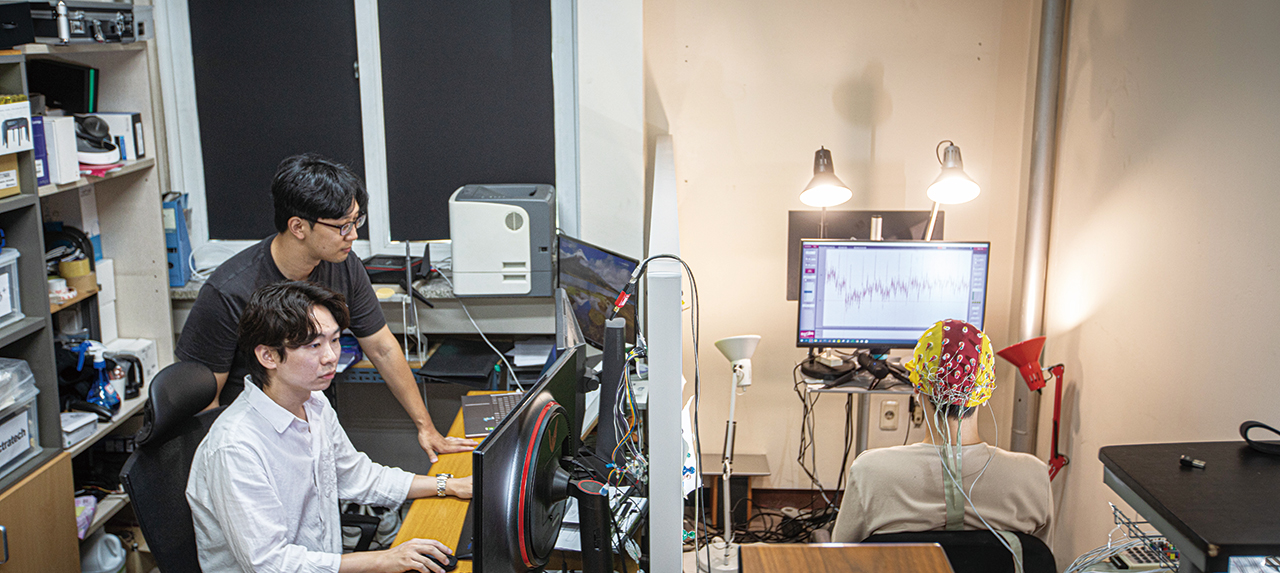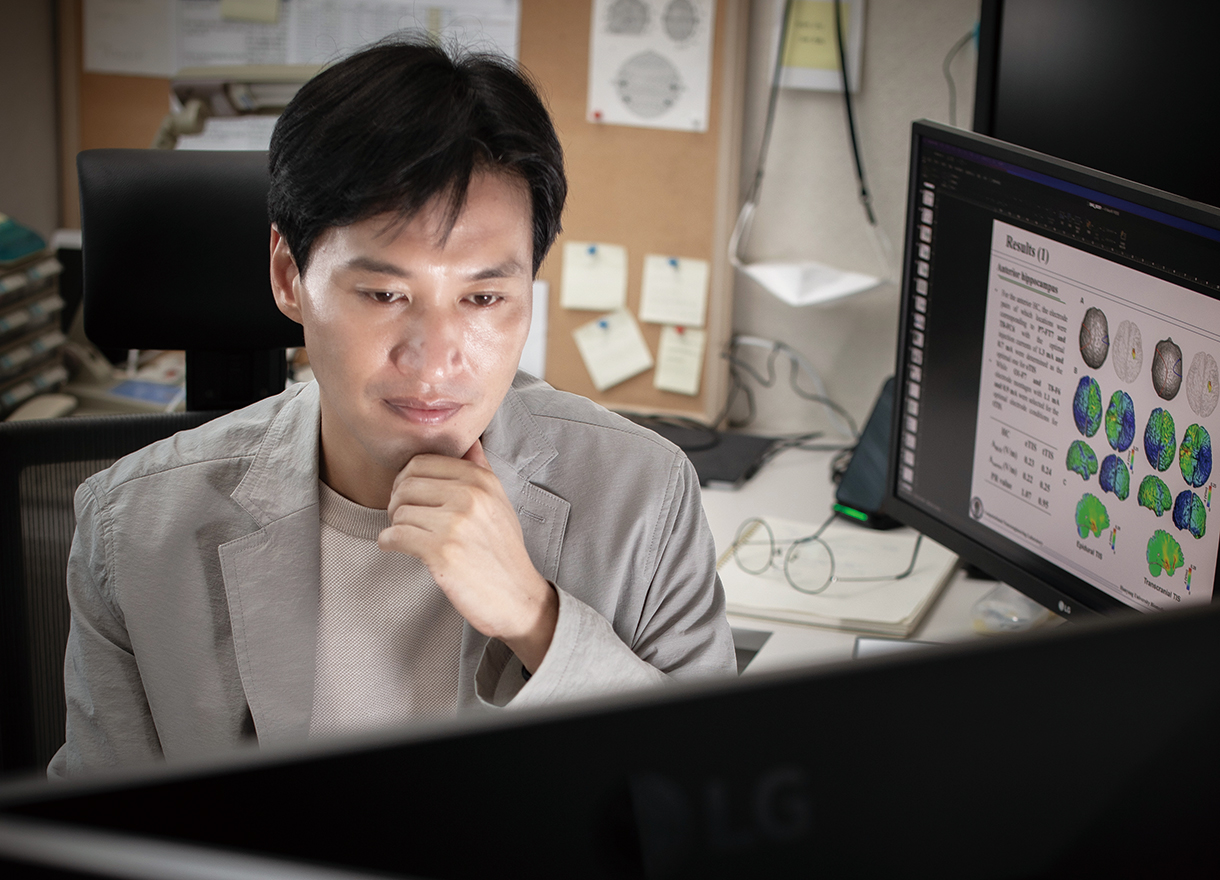

Story
세계적 기술 경쟁
미래를 좌우할 뇌과학 연구
Global Competition in Brain and Cognitive Engineering, Research to Reshape the Future
전기 · 생체공학부 바이오메디컬공학전공 임창환 교수
Professor Im Chang-Hwan, Major in Biomedical Engineering
- 글 김현지
- 사진 손초원
- Writing Kim Hyun-ji
- Photograph Son Cho-won
Scroll Down
Brain-Computer Interface (BCI), which connects the human brain with a computer or machine, is a future brain science technology that the world is paying increasing attention to. It reads signals generated in the brain to control external devices or to communicate with the outside world. Professor Im Chang-Hwan's research team, which recently succeeded in generating virtual brain waves by using advanced AI algorithms, is expected to lead the rapid growth of braincomputer interface technology.

다채롭고 광활한 범위의 뇌과학 연구
딥러닝과 예술의 만남으로 화제를 모았던 신경 스타일 전이(neural style transfer). 이 기술은 AI가 고흐나 렘브란트의 화풍을 학습한 뒤 임의의 사진을 해당 화가들의 그림처럼 변환시키는 최신 인공지능 알고리즘이다. 그동안 이미지나 음성 변환에 주로 활용됐고, 뇌파를 비롯한 뇌과학 분야에는 적용된 사례가 없었다. 임창환 교수팀은 세계 최초로 이 기술을 뇌과학에 활용해 가상의 뇌파 신호를 생성해냈다.
“뇌-컴퓨터 인터페이스 구현 시 큰 문제 중 하나는 영점조정(calibration)입니다. 스마트폰의 지문인식 기능을 사용하기 위해 먼저 지문을 등록해야 하는 것과 같은 원리죠. 시간이 오래 걸리고 번거롭기도 해서 기술 실용화를 가로막는 장애물 중 하나입니다.”
임창환 교수팀은 사용자가 15초 정도 아무것도 하지 않는 상태로 측정한 휴식상태 뇌파에 신경 스타일 전이 기술을 적용, 영점조정을 위한 뇌파 신호를 자동 생성하는 인공지능 기술을 개발했다. 이 방법을 활용하면 기존의 불편한 영점조정 과정 없이 고차원의 뇌-컴퓨터 인터페이스를 구현할 수 있다. 이번 연구성과는 관련 기술 상용화에 큰 역할을 할 전망이다.
임창환 교수는 국내에서 최초로 뇌-컴퓨터 인터페이스 연구를 시작한 이다. 현재까지 뇌공학 분야에서 190편 이상의 국제 저명 학술지 논문을 게재했고, 더 많은 이가 뇌과학에 관심을 갖도록 다양한 저서 활동을 펼쳐왔다. 2012년 당시 세계에서 가장 빠른 정신적 타자기(바라보기만 하면 타이핑이 되는 타자기)를 개발했으며, 2019년 식물인간과 유사한 상태의 환자와 뇌파로 의사소통하는 데 성공했다. 2020년에는 뇌파로 가정에 있는 주변 기기를 제어하는 시스템을 구현하고 미국 라스베이거스 CES에 전시했다. 최근에는 뇌파를 통해 온라인 교육 중 학습자의 집중도나 이해도를 파악하고 학습 효율을 높이는 ‘신경교육’ 개념을 제안, 세계 최고 교육공학 학술지에 논문을 게재한 바 있다.
A diverse and extensive range of brain science research
Neural style transfer, which drew attention as a result of deep learning joining art, is the latest artificial intelligence algorithm in which AI learns the styles of Van Gogh or Rembrandt, for example, and transforms random pictures into paintings by these artists. Until now, it has been mainly used for images or voice conversion, but has never been applied in the brain science field, including brain waves. Professor Im’s team used this technology in brain science for the first time in the world and created a virtual brain wave signal.
“One of the big challenges in implementing a brain-computer interface is calibration. It is the same principle as having to register a fingerprint first to use the fingerprint recognition function of a smartphone. It is time-consuming and cumbersome, which is one of the obstacles to the practical use of the technology.”
Professor Im Chang-Hwan's team developed an artificial intelligence technology that automatically generates EEG signals for calibration by applying a neural style transfer technology to an resting EEG measured when the user does nothing for 15 seconds. By using this method, a high-level brain-computer interface can be implemented without the existing inconvenient calibrating process. The results of this research are expected to play a major role in the commercialization of related technologies.
Professor Im Chang-Hwan was the first person in Korea to begin brain-computer interface research. To date, he has published more than 190 papers in internationally renowned academic journals in the field of brain engineering, and has worked on various writing activities to get more people interested in brain science. In 2012, he developed the fastest mental typewriter (a typewriter that types just by thinking) in the world; and in 2019, he succeeded in communicating with a patient in a vegetative state through brain waves. In 2020, he realized a system that controls devices in homes with brain waves and exhibited it at CES in Las Vegas, USA. Recently, he proposed a concept of ‘neuroeducation” that learns the concentration and comprehension levels of a person during online education through brain waves and increases learning efficiency, and published a paper in the world’s top educational technology journal.

대규모 투자로 전 세계가 경쟁 중인 뇌 연구
뇌과학은 다양한 지식이 결합되는 다학제 학문으로 그 범위가 다채롭고 광활하다. 임창환 교수 역시 뇌-컴퓨터 인터페이스 외에도 비침습적 뇌 자극(조절) 시스템, 뇌질환 진단을 위한 뉴로마커 개발 등 다양한 연구를 진행하고 있다. 2011년 세계 최초로 다중채널을 가진 뇌 전기자극 장치를 개발했고, 2016년에는 카머츠(Comets)라고 이름 붙인 뇌 전기자극 해석 소프트웨어를 공개했다. 현재 이 프로그램은 전 세계 100여 개 기관에서 사용되고 있다. 최근에는 머리 밖에서 뇌 심부를 자극하는 새로운 방식의 뇌 자극 기술을 개발해 세계적으로 인정받았다. 우울증이나 경도인지장애와 같은 뇌질환을 정량적으로 진단할 수 있는 뉴로마커, 웨어러블 밴드 형태로 간편하게 뇌 건강을 진단할 수 있는 장치 개발도 추진 중이다.
“뇌과학 분야에서 가장 대표적인 프로젝트는 미국의 ‘브레인 이니셔티브(BRAIN Initiative)’입니다. 새로운 뇌 연구 기술을 개발해 비약적으로 발전시키는 게 목표죠. 10년간 6조 원에 가까운 엄청난 연구비가 투입됐고, 후속 프로젝트가 기획되고 있어요. 유럽 연합에서도 ‘휴먼 브레인 프로젝트(Human Brain Project)’라는 대규모 뇌 연구를 진행 중입니다. 10년간 1조 3천억 원의 큰 연구비가 투자됐죠. 인간 뇌를 닮은 컴퓨터를 개발하는 게 이 프로젝트의 최종 목표입니다. 이와 비슷하게 일본이나 중국에서도 대형 연구가 추진되고 있어요.”
임창환 교수는 뇌공학 분야 기업에도 혁신적인 투자가 이어지고 있다고 설명한다. 가장 대표적인 것은 일론 머스크가 이끄는 뉴럴링크(Neuralink)다. 뉴럴링크는 2016년 설립 후 현재까지 7천억 원 이상의 투자를 받은 것으로 알려졌다. 이 외에도 지난해 FDA로부터 스텐트로드(stentrode)라는 뇌 삽입형 전극의 임상시험 허가를 받은 호주의 싱크론(Synchron), 헬멧 형태의 뇌 기능 측정장치를 개발한 미국의 커넬(Kernel)도 대규모 투자 유치에 성공했다.
“우리나라도 연구의 질적인 면에서는 뒤지지 않습니다. 특히 제가 연구하고 있는 뇌-컴퓨터 인터페이스와 뇌 전기자극이 포함된 전자약 분야는 국내 기술이 세계 최고 수준이라 자부하고 있어요. 다만 뇌과학이나 뇌공학이 워낙 방대한 분야이다 보니, 국내의 연구자 저변이 넓지 않아 일부 분야에서는 격차가 발생할 수밖에 없습니다.”
우리나라에서도 뇌과학 분야의 중요성을 인식하고 우주개발이나 원자력 기술처럼 별도의 연구지원단을 구성, 투자에 나서왔다. 2011년 대구에 정부출연연구소인 한국뇌연구원을 설립해 국내 뇌과학 발전을 선도하고 있으며, 다양한 뇌공학 기업들도 주목받는 상황이다. 불과 10년 전까지만 해도 소수에 그쳤던 관련 연구자 규모도 계속 증가 추세다.
The world competing in brain research with large-scale investments
Brain science is a multidisciplinary study that combines various types of knowledge, and its scope is diverse and wide. Professor Im Chang-Hwan also conducts various researches, in addition to brain-computer interface, such as non-invasive brain stimulation and neuromarker development for brain-disease diagnosis. In 2011, he developed the world’s first multi-channel electrical brain stimulation system, and in 2016 he released electrical brain stimulation analysis software named "Comets." Currently, the program is being used by more than 100 organizations around the world. Recently, he developed a new type of brain-stimulation technology that stimulates the deep brain from outside the head and was recognized worldwide. He is also working on the development of a neuromarker that can quantitatively diagnose brain diseases such as depression and mild cognitive impairment, and a device that can easily diagnose brain health in the form of a wearable band.
“The most well-known project in the field of brain science is the BRAIN Initiative in the USA. Its goal is to develop new brain research technology and rapidly advance it further. A tremendous amount of research funding of nearly 6 trillion Korean won has been invested over the past 10 years, and follow-up projects are planned. The European Union is also conducting a large-scale brain research initiative called the Human Brain Project. A huge amount of research funding of 1.3 trillion won was invested over 10 years. The ultimate goal of this project is to develop a computer that resembles the human brain. Similar large-scale projects are being conducted also in Japan and China.”
Professor Im Chang-Hwan explains that innovative investments are also being made in companies in the field of brain engineering. The most representative is Neuralink, led by Elon Musk. Neuralink is known to have received more than 700 billion won in investment since its establishment in 2016. Synchron of Australia, which received approval for clinical trials for a brain-implanted electrode called stentrode by the FDA last year, and Kernel of the USA, which developed a helmet-type brain function measurement device, also succeeded in attracting large-scale investments.
“Korea does not fall behind in terms of the quality of research. I can proudly say that Korea’s technology in brain-computer interface that I am researching and the electroceuticals with electrical brain stimulation, in particular, are the best in the world. However, since brain science and brain engineering have a wide range of studies, the base for research is not expanded and there are inevitably gaps in some fields.”
Recognizing the importance of the field of brain science, Korea too has formed a research support group and invested in it, as with space development and nuclear technology. In 2011, the Korea Brain Research Institute, a government-funded research institute, was established to lead domestic brain science development, and many brain engineering companies are now receiving attention. The number of related researchers, which was small only 10 years ago, also continues to increase.

미래 시대, 뇌과학에 주목해야 하는 이유
여러 첨단 기술이 접목되며 뇌과학은 다양한 분야로 확장되고, 뇌공학이 혁신적으로 발전하고 있다. 임창환 교수는 뇌과학의 중요성을 설명하며 세 가지 이유를 꼽았다. 첫 번째는 뇌질환 극복이다. 아직도 우리는 여러 뇌질환의 원인과 그 치료법을 명확히 알지 못한다. 특히 치매와 같은 퇴행성 뇌질환은 평균수명 증가와 함께 큰 사회 문제로 대두되고 있다. 치매는 80세 이상 노인의 20%, 90세 이상 노인의 30%가 걸리는 심각한 뇌질환이다. 뇌과학 연구를 통해 뇌질환 극복의 열쇠를 찾는 게 시급하다. 한편 뇌나 신경계를 전기, 자기, 초음파, 빛 등으로 자극하는 전자약은 내성과 부작용이 없어 정신질환 및 뇌질환을 효과적으로 치료할 새로운 방법으로 기대된다.
두 번째는 새로운 인공지능과 컴퓨터의 개발이다. 인간의 뇌는 소량의 에너지를 쓰면서도 아주 뛰어난 인지능력을 발휘한다. 오랜 시간을 거치며 가장 효율이 높은 컴퓨터로 진화한 결과다. 따라서 인간 뇌의 작동 원리를 파악하고, 이를 모방해 인공지능이나 컴퓨터를 개발하면 적은 에너지로 탁월한 성능을 구현할 수 있다.
세 번째는 인간 뇌에 관한 이해가 우리 사회에 큰 영향을 미치기 때문이다. 성별이나 인종에 따라 뇌가 다를까? 인간은 자유의지를 가지고 있을까? 노력하면 머리가 좋아질까? 이런 질문들에 어떤 결론이 나느냐에 따라 다양한 사회적 문제가 생길 수도, 반대로 여러 갈등이 해소될 수도 있을 것이다. 뇌과학은 앞으로 우리의 일상을 어떻게 바꾸게 될까.
“아직은 장애나 질환 극복에 연구 초점이 맞춰져 있습니다. 하지만 일반인들에게 적용할 수 있는 기술도 보급될 것이라 기대합니다. 교육이나 게임, 마케팅, 여러 산업 분야와도 큰 시너지를 낼 것입니다. 저희 연구실에서도 뇌-컴퓨터 인터페이스 기술을 바탕으로 다양한 제품의 선호도를 정량적으로 평가하는 뉴로마케팅 연구, 자율주행 자동차 보급 시 중요 이슈가 될 탑승자의 멀미 측정 연구 등을 활발히 수행하고 있어요.”
임창환 교수는 뇌과학을 통해 인류의 삶이 크게 바뀔 것이라 강조했다. 실제로 임창환 교수팀은 기억력이나 동체시력과 같은 인지·감각 능력을 뇌 자극으로 향상하는 ‘인간 증강’ 기술, 머릿속으로 말을 생각하면 음성으로 합성하는 ‘상상 음성인식’ 기술, 병사의 생각을 읽어 전투력을 높이고 정신건강까지 케어하는 기술, 뇌파로 착용형 로봇을 제어하는 기술 등 영화 속에서나 볼 법한 기술들에까지 연구 범위를 확장하고 있다.
인류 삶에 이바지할 새로운 뇌과학 기술을 계속 개발하겠노라 밝힌 임창환 교수. 그는 오늘도 뇌의 비밀을 풀기 위해 고군분투 중이다.
Why we need to pay attention to brain science in the future
As many advanced technologies are being merged, brain science is expanding into various fields and brain engineering is developing innovatively. Professor Im ChangHwan explained three reasons for the growing importance of brain science: The first is conquering brain diseases. There are still many brain diseases that we do not know the causes of or how to treat them. In particular, degenerative brain diseases such as dementia are rising as a major social problem with the increase in life expectancy. Dementia is a serious brain disease that 20% of people over 80 years of age and 30% of people over 90 suffer from. There is thus an urgent need to find the key to overcoming brain diseases through brain science research. Electroceuticals that stimulate the brain or nervous system with electricity, magnetism, ultrasound, or light are expected to be utilized as a new method to effectively treat mental and brain diseases because they have no tolerance and side effects.
The second is the development of new artificial intelligence and computers. The human brain uses a small amount of energy to exhibit excellent cognitive abilities. It is the result of the evolution into the most efficient computer over a long period of time. Therefore, by understanding the principle of a working human brain and developing artificial intelligence or computers by imitating it, we will be able to realize excellent performance with little energy.
Thirdly, understanding the human brain greatly affects our society. Do brains differ by gender or race? Do humans have free will? Will humans be smarter by making efforts? Depending on the answers to these questions, various social problems may arise, or conflicts may be resolved. How will brain science change our lives in the future?
“The research focus for now is on overcoming disabilities and diseases. However, we expect to develop technologies that can be applied to the general public. It will also create synergy with the fields of education, game, marketing, and other industries. In our laboratory, we are also actively conducting researches in areas such as neuro-marketing that quantitatively evaluates people's preferences for various products based on braincomputer interface technology; and measuring motion sickness of passengers that will become an important issue when autonomous vehicles are used.”
Professor Im Chang-Hwan emphasized that human lives will be transformed through brain science. In fact, Professor Im’s team is expanding the scope of its researches into technologies that can only be seen in movies, including “human augmentation” technology that enhances cognitive and sensory abilities such as memory and dynamic visual acuity, an “imagined speech recognition” technology that synthesizes words when thinking in the brain; and technology that reads soldiers’ thoughts to increase their morale and takes care of their mental health; and technology that controls wearable robots with brain waves.
Professor Im Chang-Hwan intends to continue developing new brain science technologies that will contribute to enhancing people's lives, by striving to discover the secrets of the brain.
뇌과학은 다양한 분야로 확장되며 혁신적으로 발전하고 있다.
뇌과학을 통해 인류의 삶은 크게 바뀔 것이다
Brain science is expanding into various fields and developing progressively. People's lives will be transformed through brain science.

